Building and Construction Project: Site Management Report
VerifiedAdded on 2021/10/06
|19
|3267
|92
Report
AI Summary
This comprehensive construction project report addresses key aspects of site management and operations. It begins by establishing site communication processes, including meeting schedules and attendee details. The report then delves into Work Health and Safety (WHS) requirements, detailing first aid provisions based on site specifics and relevant legislation. A significant portion is dedicated to producing a Safe Work Method Statement (SWMS) for excavator use, alongside a site-specific safety induction plan. The report also covers material and equipment management, including order schedules and a network diagram. Furthermore, it includes a variation claim for design changes, and a projected project payment schedule with contract references. The report provides a detailed analysis of the project's various stages, from initial planning to financial management, illustrating critical aspects of construction project management.
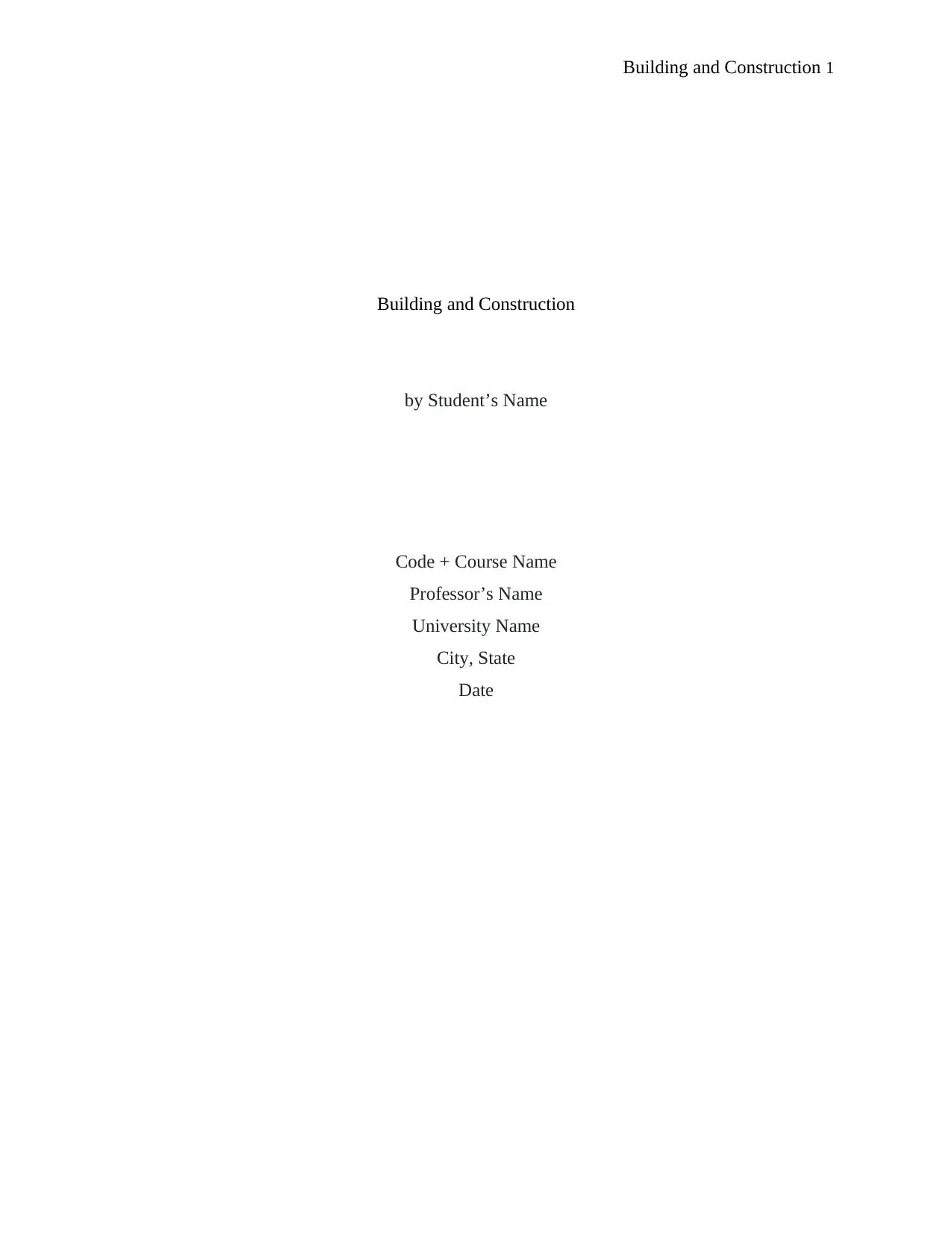
Building and Construction 1
Building and Construction
by Student’s Name
Code + Course Name
Professor’s Name
University Name
City, State
Date
Building and Construction
by Student’s Name
Code + Course Name
Professor’s Name
University Name
City, State
Date
Paraphrase This Document
Need a fresh take? Get an instant paraphrase of this document with our AI Paraphraser
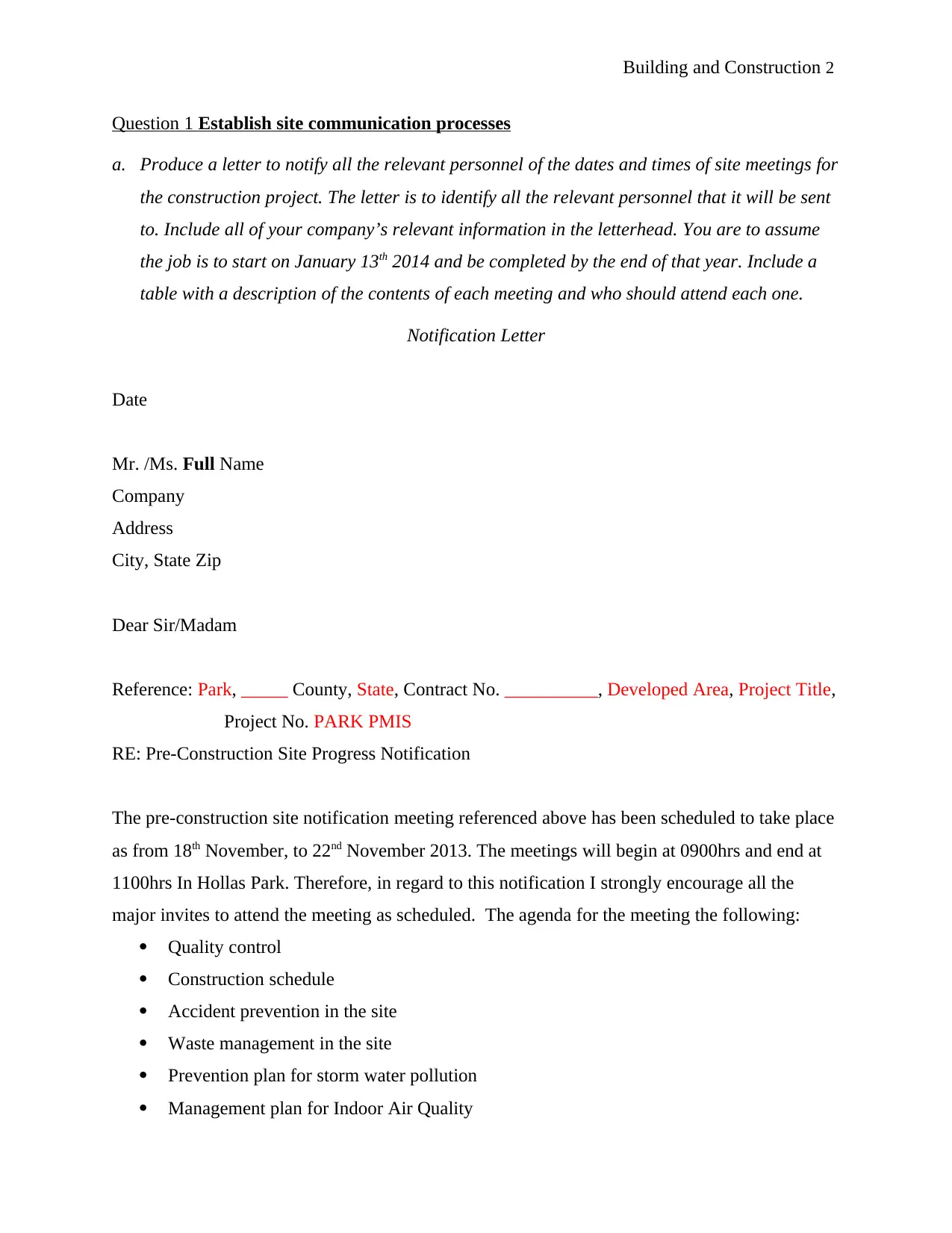
Building and Construction 2
Question 1 Establish site communication processes
a. Produce a letter to notify all the relevant personnel of the dates and times of site meetings for
the construction project. The letter is to identify all the relevant personnel that it will be sent
to. Include all of your company’s relevant information in the letterhead. You are to assume
the job is to start on January 13th 2014 and be completed by the end of that year. Include a
table with a description of the contents of each meeting and who should attend each one.
Notification Letter
Date
Mr. /Ms. Full Name
Company
Address
City, State Zip
Dear Sir/Madam
Reference: Park, _____ County, State, Contract No. __________, Developed Area, Project Title,
Project No. PARK PMIS
RE: Pre-Construction Site Progress Notification
The pre-construction site notification meeting referenced above has been scheduled to take place
as from 18th November, to 22nd November 2013. The meetings will begin at 0900hrs and end at
1100hrs In Hollas Park. Therefore, in regard to this notification I strongly encourage all the
major invites to attend the meeting as scheduled. The agenda for the meeting the following:
Quality control
Construction schedule
Accident prevention in the site
Waste management in the site
Prevention plan for storm water pollution
Management plan for Indoor Air Quality
Question 1 Establish site communication processes
a. Produce a letter to notify all the relevant personnel of the dates and times of site meetings for
the construction project. The letter is to identify all the relevant personnel that it will be sent
to. Include all of your company’s relevant information in the letterhead. You are to assume
the job is to start on January 13th 2014 and be completed by the end of that year. Include a
table with a description of the contents of each meeting and who should attend each one.
Notification Letter
Date
Mr. /Ms. Full Name
Company
Address
City, State Zip
Dear Sir/Madam
Reference: Park, _____ County, State, Contract No. __________, Developed Area, Project Title,
Project No. PARK PMIS
RE: Pre-Construction Site Progress Notification
The pre-construction site notification meeting referenced above has been scheduled to take place
as from 18th November, to 22nd November 2013. The meetings will begin at 0900hrs and end at
1100hrs In Hollas Park. Therefore, in regard to this notification I strongly encourage all the
major invites to attend the meeting as scheduled. The agenda for the meeting the following:
Quality control
Construction schedule
Accident prevention in the site
Waste management in the site
Prevention plan for storm water pollution
Management plan for Indoor Air Quality
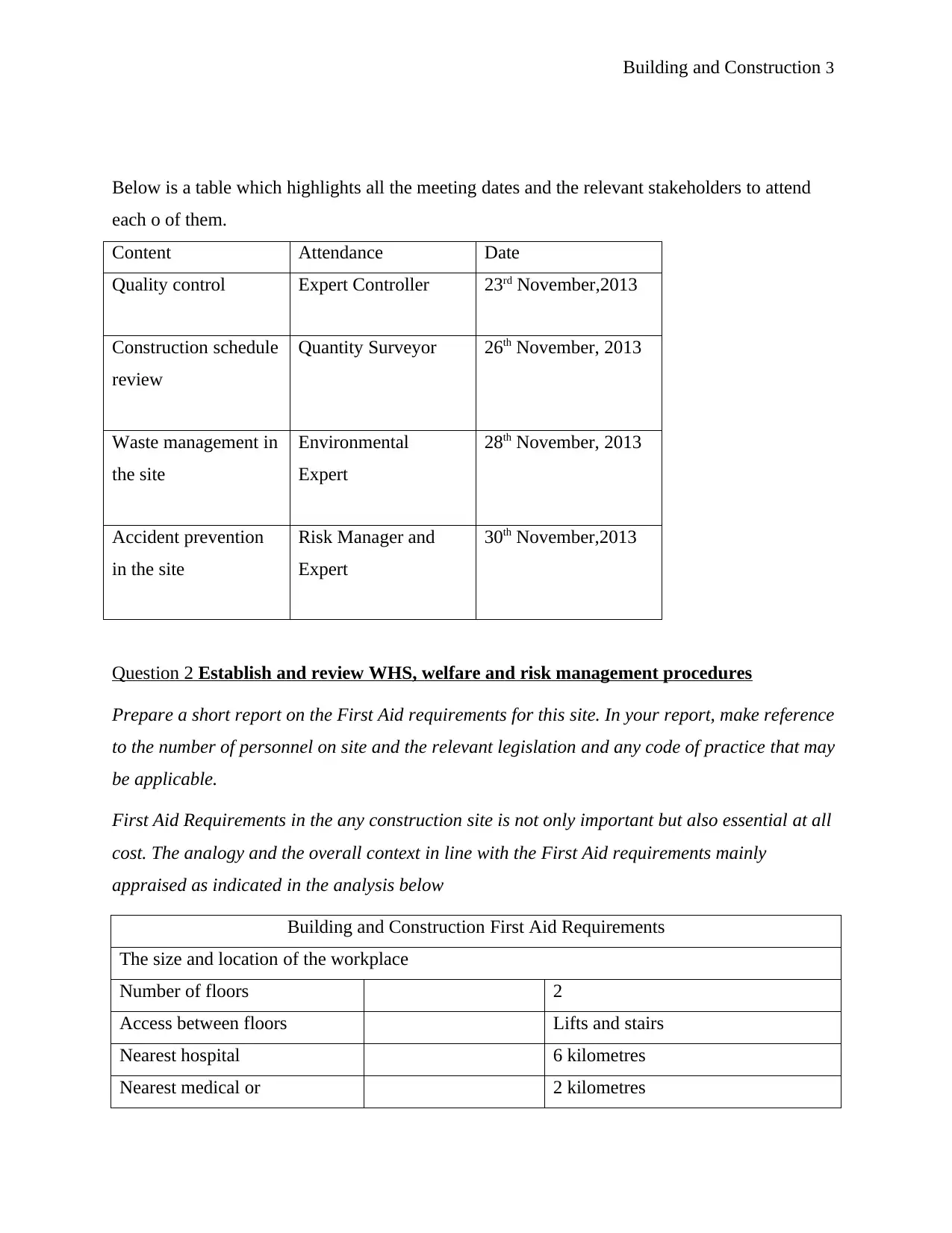
Building and Construction 3
Below is a table which highlights all the meeting dates and the relevant stakeholders to attend
each o of them.
Content Attendance Date
Quality control Expert Controller 23rd November,2013
Construction schedule
review
Quantity Surveyor 26th November, 2013
Waste management in
the site
Environmental
Expert
28th November, 2013
Accident prevention
in the site
Risk Manager and
Expert
30th November,2013
Question 2 Establish and review WHS, welfare and risk management procedures
Prepare a short report on the First Aid requirements for this site. In your report, make reference
to the number of personnel on site and the relevant legislation and any code of practice that may
be applicable.
First Aid Requirements in the any construction site is not only important but also essential at all
cost. The analogy and the overall context in line with the First Aid requirements mainly
appraised as indicated in the analysis below
Building and Construction First Aid Requirements
The size and location of the workplace
Number of floors 2
Access between floors Lifts and stairs
Nearest hospital 6 kilometres
Nearest medical or 2 kilometres
Below is a table which highlights all the meeting dates and the relevant stakeholders to attend
each o of them.
Content Attendance Date
Quality control Expert Controller 23rd November,2013
Construction schedule
review
Quantity Surveyor 26th November, 2013
Waste management in
the site
Environmental
Expert
28th November, 2013
Accident prevention
in the site
Risk Manager and
Expert
30th November,2013
Question 2 Establish and review WHS, welfare and risk management procedures
Prepare a short report on the First Aid requirements for this site. In your report, make reference
to the number of personnel on site and the relevant legislation and any code of practice that may
be applicable.
First Aid Requirements in the any construction site is not only important but also essential at all
cost. The analogy and the overall context in line with the First Aid requirements mainly
appraised as indicated in the analysis below
Building and Construction First Aid Requirements
The size and location of the workplace
Number of floors 2
Access between floors Lifts and stairs
Nearest hospital 6 kilometres
Nearest medical or 2 kilometres
⊘ This is a preview!⊘
Do you want full access?
Subscribe today to unlock all pages.

Trusted by 1+ million students worldwide
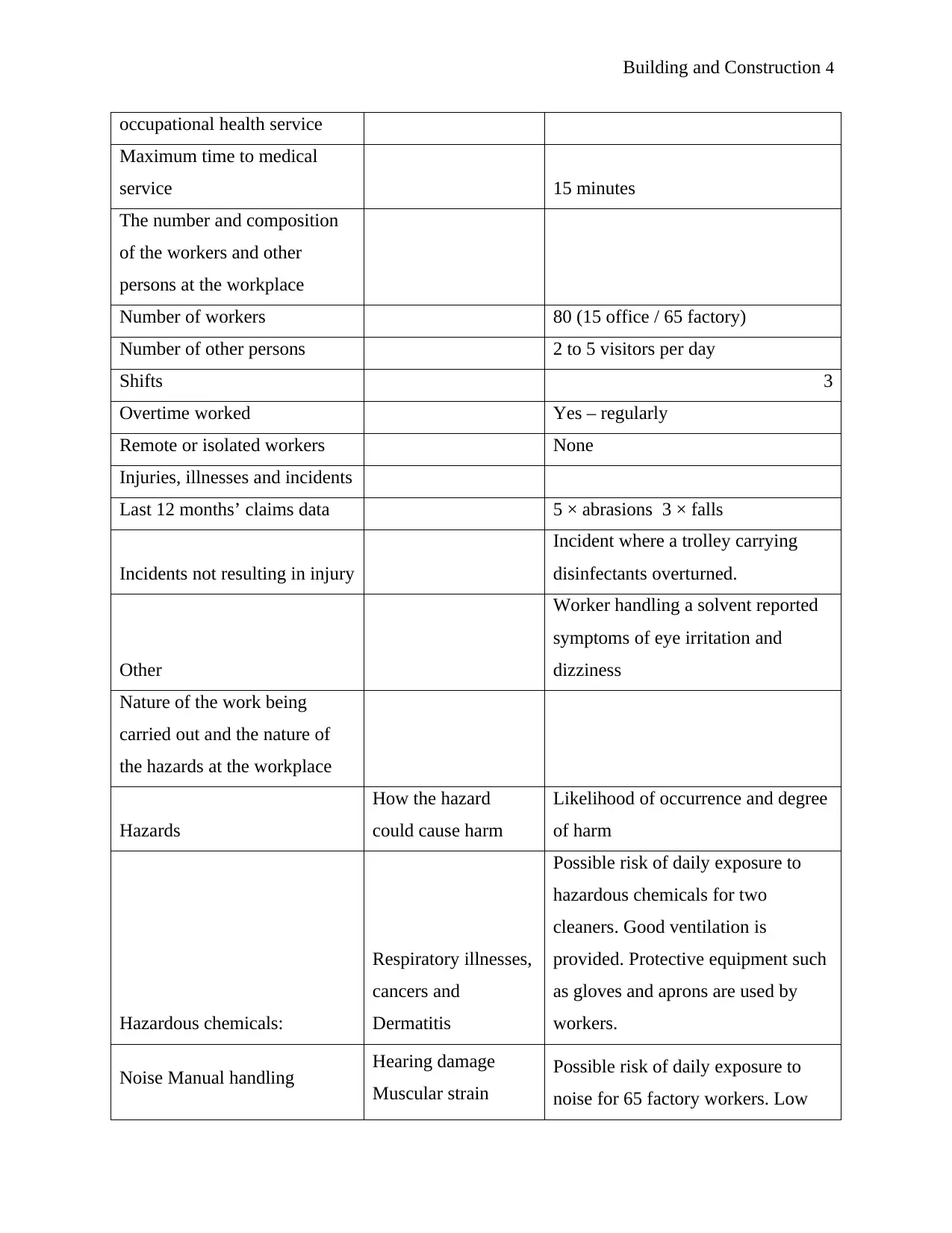
Building and Construction 4
occupational health service
Maximum time to medical
service 15 minutes
The number and composition
of the workers and other
persons at the workplace
Number of workers 80 (15 office / 65 factory)
Number of other persons 2 to 5 visitors per day
Shifts 3
Overtime worked Yes – regularly
Remote or isolated workers None
Injuries, illnesses and incidents
Last 12 months’ claims data 5 × abrasions 3 × falls
Incidents not resulting in injury
Incident where a trolley carrying
disinfectants overturned.
Other
Worker handling a solvent reported
symptoms of eye irritation and
dizziness
Nature of the work being
carried out and the nature of
the hazards at the workplace
Hazards
How the hazard
could cause harm
Likelihood of occurrence and degree
of harm
Hazardous chemicals:
Respiratory illnesses,
cancers and
Dermatitis
Possible risk of daily exposure to
hazardous chemicals for two
cleaners. Good ventilation is
provided. Protective equipment such
as gloves and aprons are used by
workers.
Noise Manual handling Hearing damage
Muscular strain
Possible risk of daily exposure to
noise for 65 factory workers. Low
occupational health service
Maximum time to medical
service 15 minutes
The number and composition
of the workers and other
persons at the workplace
Number of workers 80 (15 office / 65 factory)
Number of other persons 2 to 5 visitors per day
Shifts 3
Overtime worked Yes – regularly
Remote or isolated workers None
Injuries, illnesses and incidents
Last 12 months’ claims data 5 × abrasions 3 × falls
Incidents not resulting in injury
Incident where a trolley carrying
disinfectants overturned.
Other
Worker handling a solvent reported
symptoms of eye irritation and
dizziness
Nature of the work being
carried out and the nature of
the hazards at the workplace
Hazards
How the hazard
could cause harm
Likelihood of occurrence and degree
of harm
Hazardous chemicals:
Respiratory illnesses,
cancers and
Dermatitis
Possible risk of daily exposure to
hazardous chemicals for two
cleaners. Good ventilation is
provided. Protective equipment such
as gloves and aprons are used by
workers.
Noise Manual handling Hearing damage
Muscular strain
Possible risk of daily exposure to
noise for 65 factory workers. Low
Paraphrase This Document
Need a fresh take? Get an instant paraphrase of this document with our AI Paraphraser
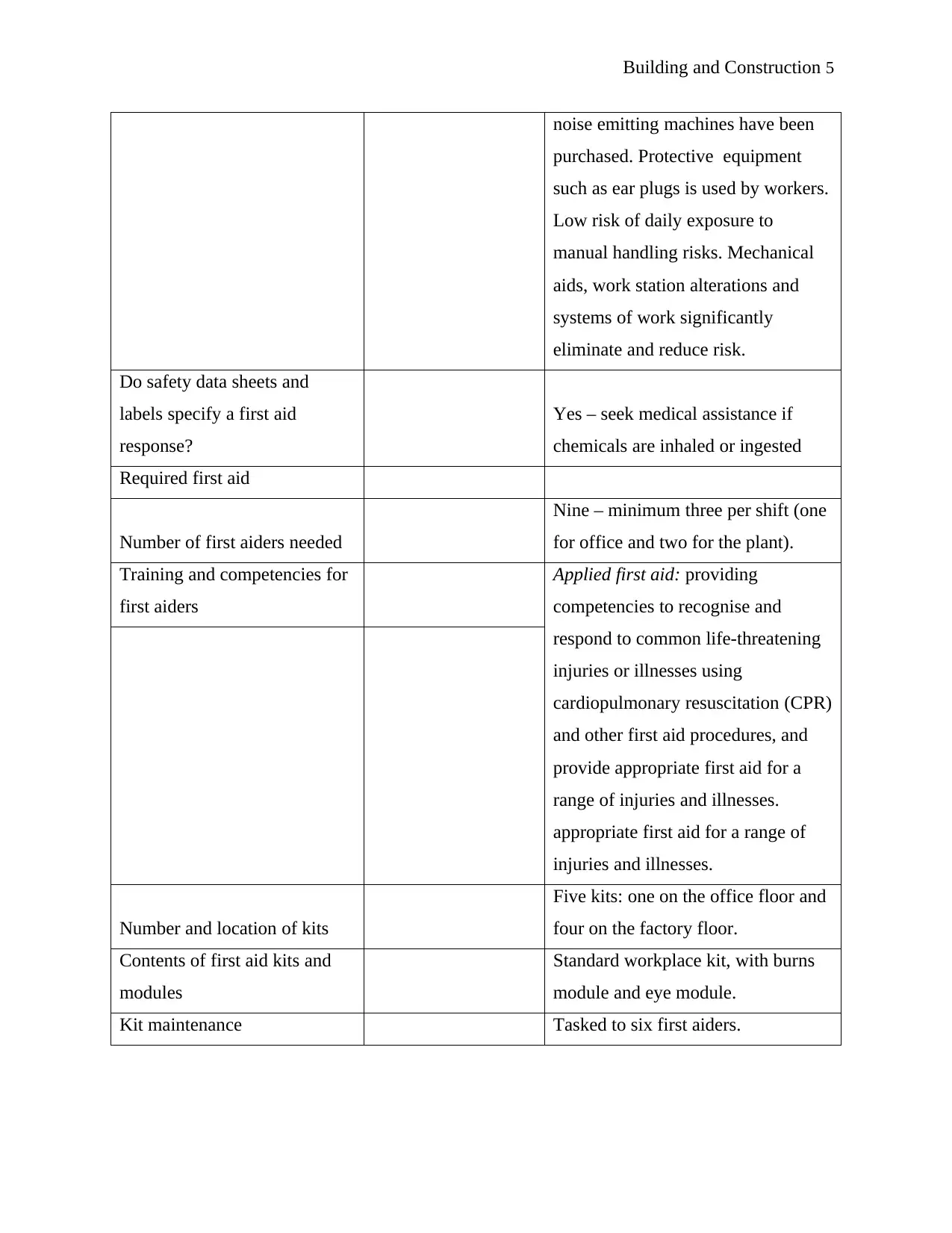
Building and Construction 5
noise emitting machines have been
purchased. Protective equipment
such as ear plugs is used by workers.
Low risk of daily exposure to
manual handling risks. Mechanical
aids, work station alterations and
systems of work significantly
eliminate and reduce risk.
Do safety data sheets and
labels specify a first aid
response?
Yes – seek medical assistance if
chemicals are inhaled or ingested
Required first aid
Number of first aiders needed
Nine – minimum three per shift (one
for office and two for the plant).
Training and competencies for
first aiders
Applied first aid: providing
competencies to recognise and
respond to common life-threatening
injuries or illnesses using
cardiopulmonary resuscitation (CPR)
and other first aid procedures, and
provide appropriate first aid for a
range of injuries and illnesses.
appropriate first aid for a range of
injuries and illnesses.
Number and location of kits
Five kits: one on the office floor and
four on the factory floor.
Contents of first aid kits and
modules
Standard workplace kit, with burns
module and eye module.
Kit maintenance Tasked to six first aiders.
noise emitting machines have been
purchased. Protective equipment
such as ear plugs is used by workers.
Low risk of daily exposure to
manual handling risks. Mechanical
aids, work station alterations and
systems of work significantly
eliminate and reduce risk.
Do safety data sheets and
labels specify a first aid
response?
Yes – seek medical assistance if
chemicals are inhaled or ingested
Required first aid
Number of first aiders needed
Nine – minimum three per shift (one
for office and two for the plant).
Training and competencies for
first aiders
Applied first aid: providing
competencies to recognise and
respond to common life-threatening
injuries or illnesses using
cardiopulmonary resuscitation (CPR)
and other first aid procedures, and
provide appropriate first aid for a
range of injuries and illnesses.
appropriate first aid for a range of
injuries and illnesses.
Number and location of kits
Five kits: one on the office floor and
four on the factory floor.
Contents of first aid kits and
modules
Standard workplace kit, with burns
module and eye module.
Kit maintenance Tasked to six first aiders.
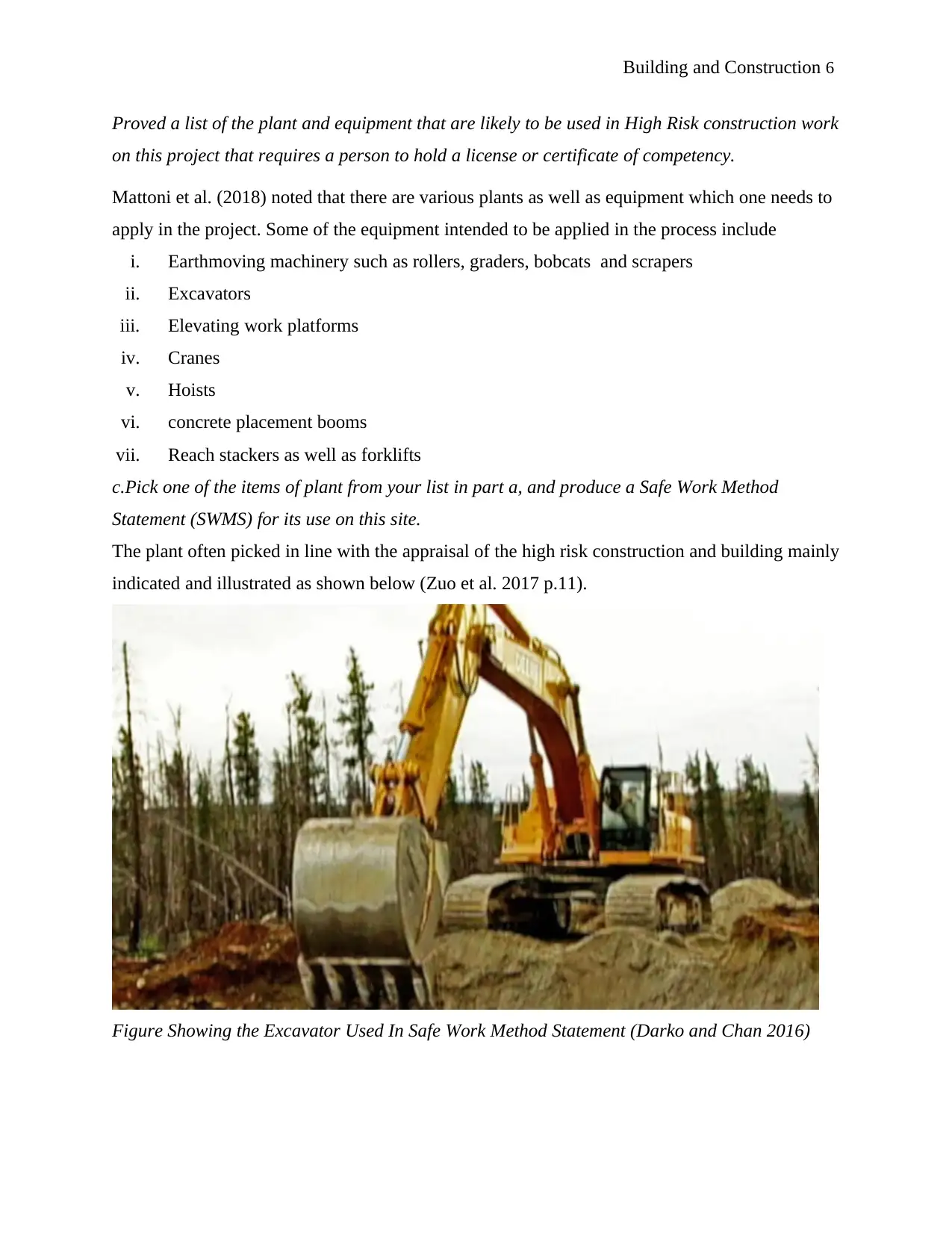
Building and Construction 6
Proved a list of the plant and equipment that are likely to be used in High Risk construction work
on this project that requires a person to hold a license or certificate of competency.
Mattoni et al. (2018) noted that there are various plants as well as equipment which one needs to
apply in the project. Some of the equipment intended to be applied in the process include
i. Earthmoving machinery such as rollers, graders, bobcats and scrapers
ii. Excavators
iii. Elevating work platforms
iv. Cranes
v. Hoists
vi. concrete placement booms
vii. Reach stackers as well as forklifts
c.Pick one of the items of plant from your list in part a, and produce a Safe Work Method
Statement (SWMS) for its use on this site.
The plant often picked in line with the appraisal of the high risk construction and building mainly
indicated and illustrated as shown below (Zuo et al. 2017 p.11).
Figure Showing the Excavator Used In Safe Work Method Statement (Darko and Chan 2016)
Proved a list of the plant and equipment that are likely to be used in High Risk construction work
on this project that requires a person to hold a license or certificate of competency.
Mattoni et al. (2018) noted that there are various plants as well as equipment which one needs to
apply in the project. Some of the equipment intended to be applied in the process include
i. Earthmoving machinery such as rollers, graders, bobcats and scrapers
ii. Excavators
iii. Elevating work platforms
iv. Cranes
v. Hoists
vi. concrete placement booms
vii. Reach stackers as well as forklifts
c.Pick one of the items of plant from your list in part a, and produce a Safe Work Method
Statement (SWMS) for its use on this site.
The plant often picked in line with the appraisal of the high risk construction and building mainly
indicated and illustrated as shown below (Zuo et al. 2017 p.11).
Figure Showing the Excavator Used In Safe Work Method Statement (Darko and Chan 2016)
⊘ This is a preview!⊘
Do you want full access?
Subscribe today to unlock all pages.

Trusted by 1+ million students worldwide
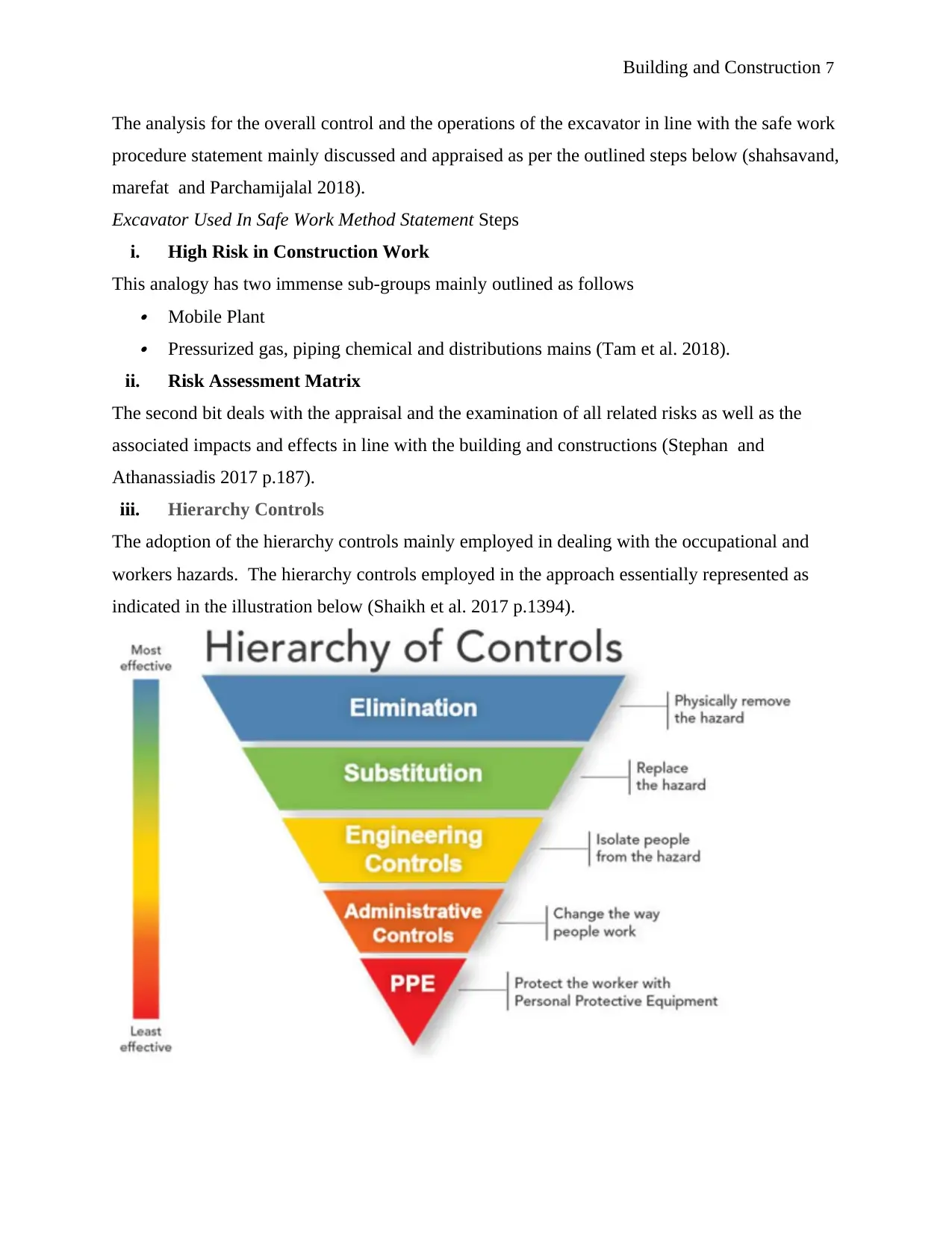
Building and Construction 7
The analysis for the overall control and the operations of the excavator in line with the safe work
procedure statement mainly discussed and appraised as per the outlined steps below (shahsavand,
marefat and Parchamijalal 2018).
Excavator Used In Safe Work Method Statement Steps
i. High Risk in Construction Work
This analogy has two immense sub-groups mainly outlined as follows Mobile Plant Pressurized gas, piping chemical and distributions mains (Tam et al. 2018).
ii. Risk Assessment Matrix
The second bit deals with the appraisal and the examination of all related risks as well as the
associated impacts and effects in line with the building and constructions (Stephan and
Athanassiadis 2017 p.187).
iii. Hierarchy Controls
The adoption of the hierarchy controls mainly employed in dealing with the occupational and
workers hazards. The hierarchy controls employed in the approach essentially represented as
indicated in the illustration below (Shaikh et al. 2017 p.1394).
The analysis for the overall control and the operations of the excavator in line with the safe work
procedure statement mainly discussed and appraised as per the outlined steps below (shahsavand,
marefat and Parchamijalal 2018).
Excavator Used In Safe Work Method Statement Steps
i. High Risk in Construction Work
This analogy has two immense sub-groups mainly outlined as follows Mobile Plant Pressurized gas, piping chemical and distributions mains (Tam et al. 2018).
ii. Risk Assessment Matrix
The second bit deals with the appraisal and the examination of all related risks as well as the
associated impacts and effects in line with the building and constructions (Stephan and
Athanassiadis 2017 p.187).
iii. Hierarchy Controls
The adoption of the hierarchy controls mainly employed in dealing with the occupational and
workers hazards. The hierarchy controls employed in the approach essentially represented as
indicated in the illustration below (Shaikh et al. 2017 p.1394).
Paraphrase This Document
Need a fresh take? Get an instant paraphrase of this document with our AI Paraphraser
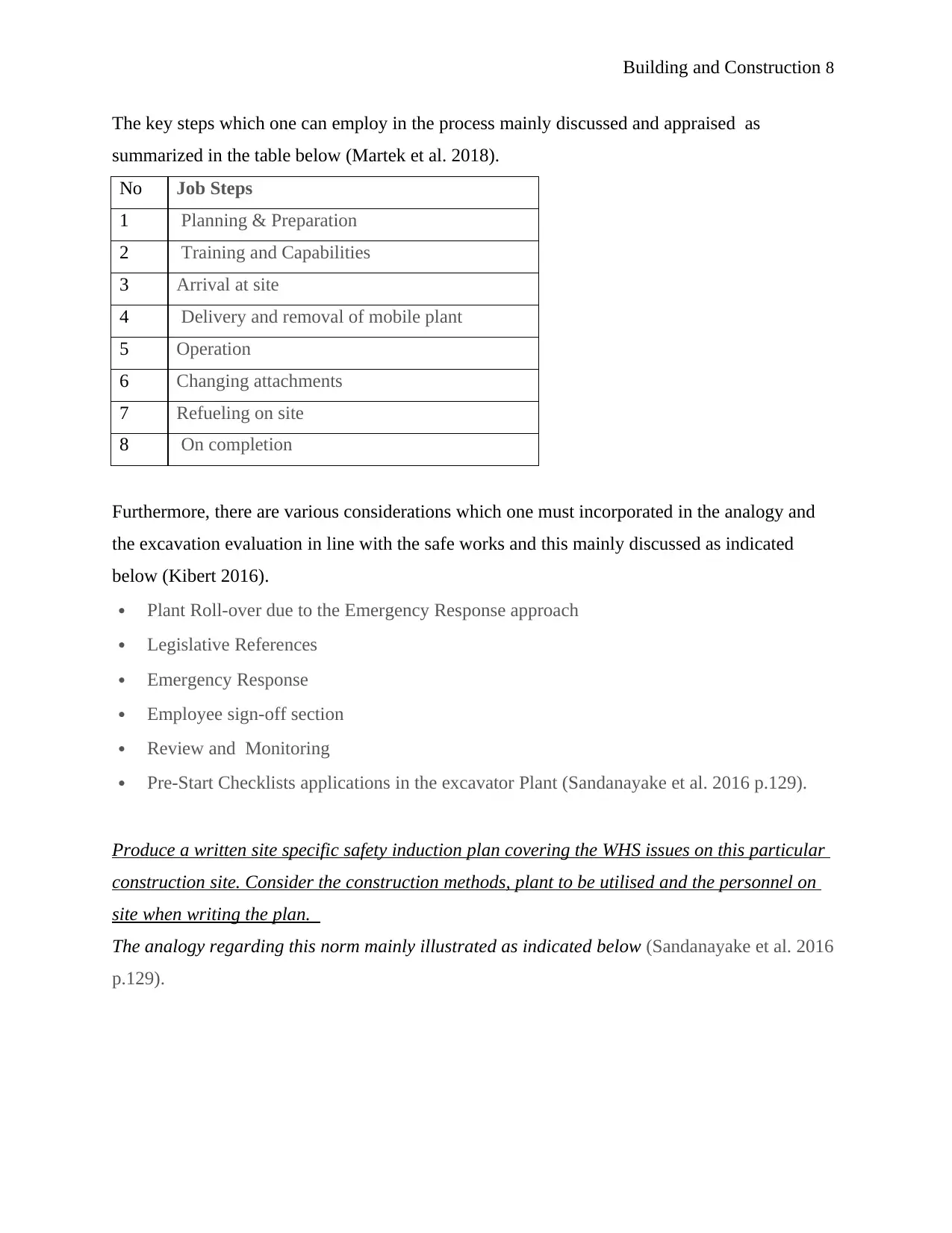
Building and Construction 8
The key steps which one can employ in the process mainly discussed and appraised as
summarized in the table below (Martek et al. 2018).
No Job Steps
1 Planning & Preparation
2 Training and Capabilities
3 Arrival at site
4 Delivery and removal of mobile plant
5 Operation
6 Changing attachments
7 Refueling on site
8 On completion
Furthermore, there are various considerations which one must incorporated in the analogy and
the excavation evaluation in line with the safe works and this mainly discussed as indicated
below (Kibert 2016).
Plant Roll-over due to the Emergency Response approach
Legislative References
Emergency Response
Employee sign-off section
Review and Monitoring
Pre-Start Checklists applications in the excavator Plant (Sandanayake et al. 2016 p.129).
Produce a written site specific safety induction plan covering the WHS issues on this particular
construction site. Consider the construction methods, plant to be utilised and the personnel on
site when writing the plan.
The analogy regarding this norm mainly illustrated as indicated below (Sandanayake et al. 2016
p.129).
The key steps which one can employ in the process mainly discussed and appraised as
summarized in the table below (Martek et al. 2018).
No Job Steps
1 Planning & Preparation
2 Training and Capabilities
3 Arrival at site
4 Delivery and removal of mobile plant
5 Operation
6 Changing attachments
7 Refueling on site
8 On completion
Furthermore, there are various considerations which one must incorporated in the analogy and
the excavation evaluation in line with the safe works and this mainly discussed as indicated
below (Kibert 2016).
Plant Roll-over due to the Emergency Response approach
Legislative References
Emergency Response
Employee sign-off section
Review and Monitoring
Pre-Start Checklists applications in the excavator Plant (Sandanayake et al. 2016 p.129).
Produce a written site specific safety induction plan covering the WHS issues on this particular
construction site. Consider the construction methods, plant to be utilised and the personnel on
site when writing the plan.
The analogy regarding this norm mainly illustrated as indicated below (Sandanayake et al. 2016
p.129).
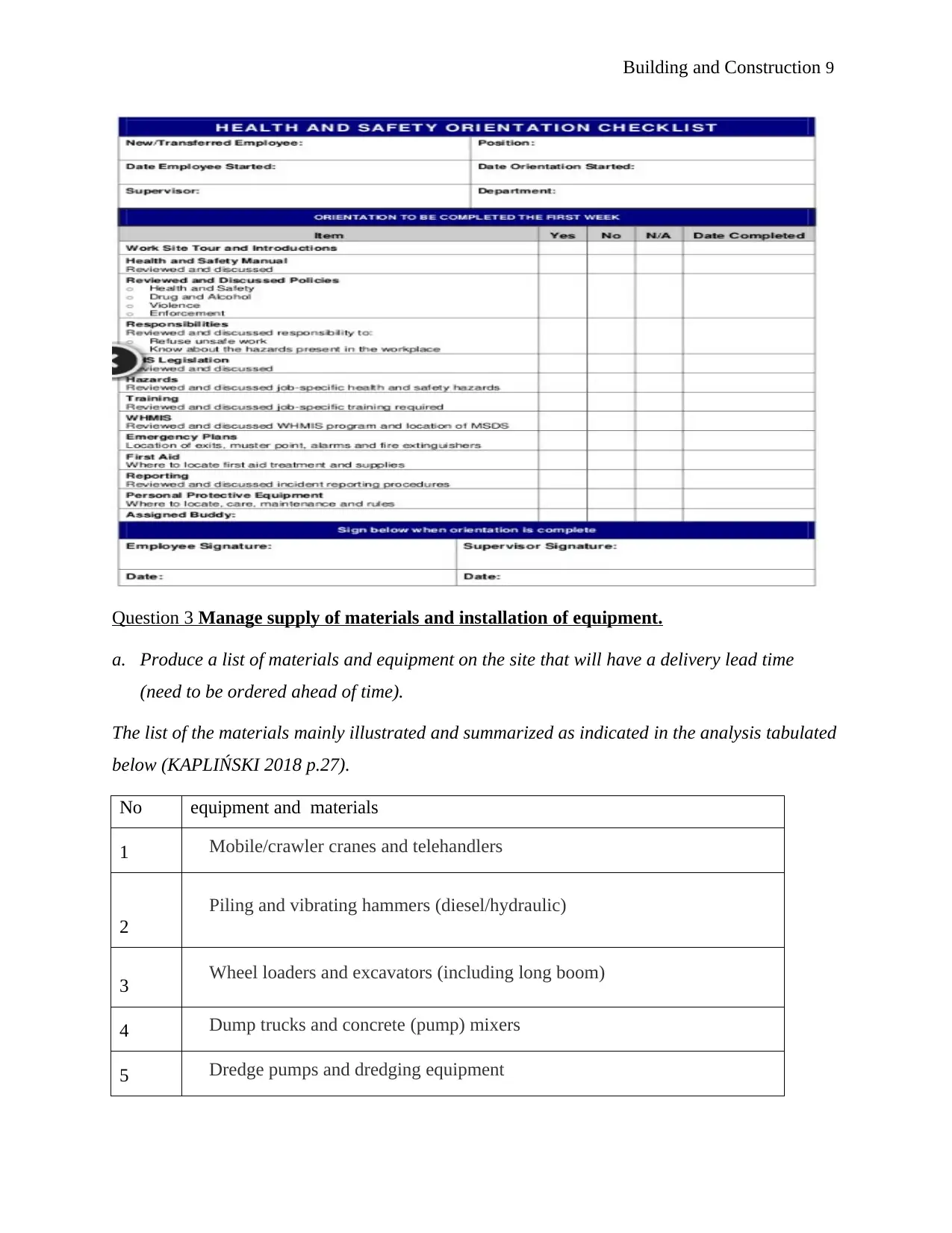
Building and Construction 9
Question 3 Manage supply of materials and installation of equipment.
a. Produce a list of materials and equipment on the site that will have a delivery lead time
(need to be ordered ahead of time).
The list of the materials mainly illustrated and summarized as indicated in the analysis tabulated
below (KAPLIŃSKI 2018 p.27).
No equipment and materials
1 Mobile/crawler cranes and telehandlers
2
Piling and vibrating hammers (diesel/hydraulic)
3 Wheel loaders and excavators (including long boom)
4 Dump trucks and concrete (pump) mixers
5 Dredge pumps and dredging equipment
Question 3 Manage supply of materials and installation of equipment.
a. Produce a list of materials and equipment on the site that will have a delivery lead time
(need to be ordered ahead of time).
The list of the materials mainly illustrated and summarized as indicated in the analysis tabulated
below (KAPLIŃSKI 2018 p.27).
No equipment and materials
1 Mobile/crawler cranes and telehandlers
2
Piling and vibrating hammers (diesel/hydraulic)
3 Wheel loaders and excavators (including long boom)
4 Dump trucks and concrete (pump) mixers
5 Dredge pumps and dredging equipment
⊘ This is a preview!⊘
Do you want full access?
Subscribe today to unlock all pages.

Trusted by 1+ million students worldwide
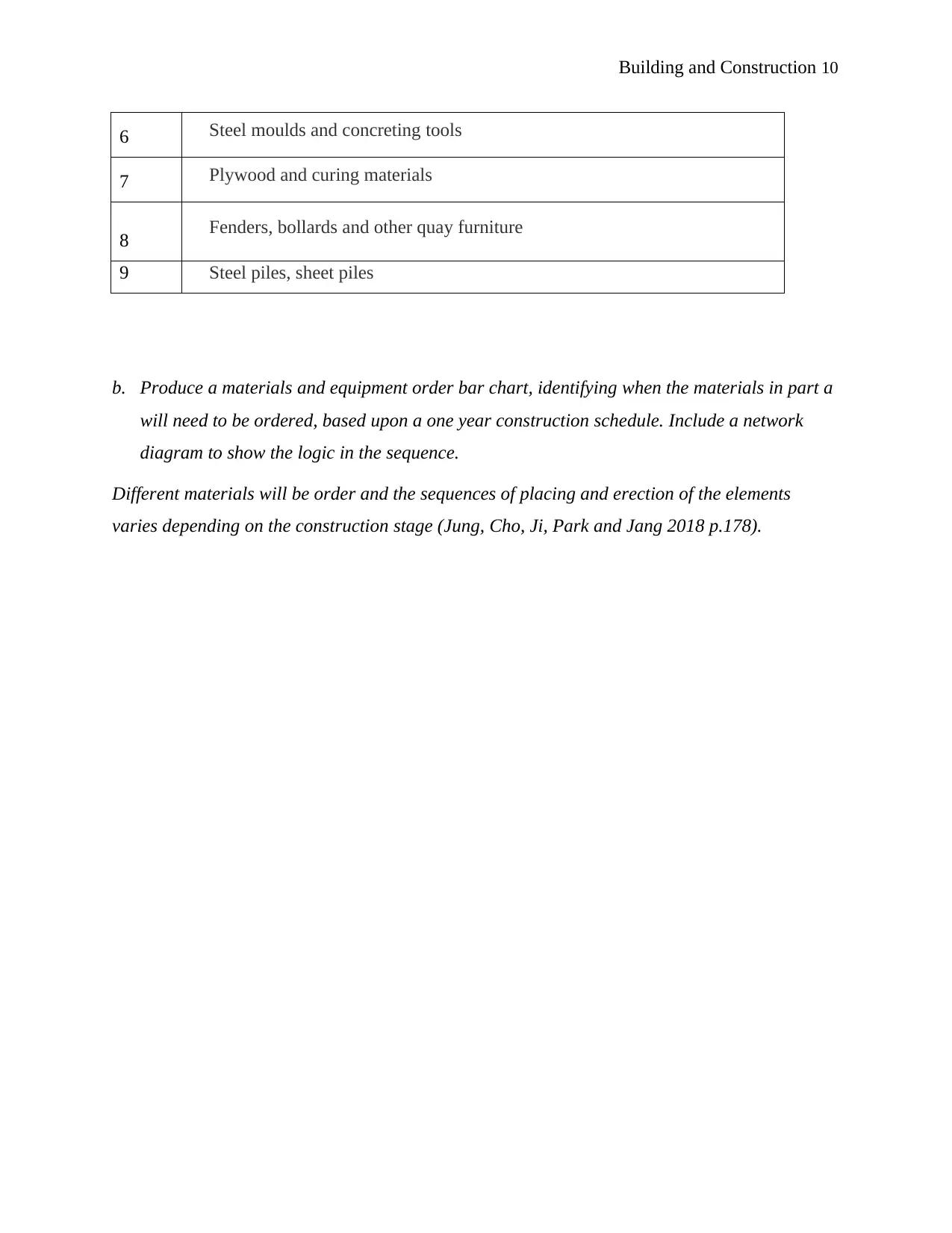
Building and Construction 10
6 Steel moulds and concreting tools
7 Plywood and curing materials
8 Fenders, bollards and other quay furniture
9 Steel piles, sheet piles
b. Produce a materials and equipment order bar chart, identifying when the materials in part a
will need to be ordered, based upon a one year construction schedule. Include a network
diagram to show the logic in the sequence.
Different materials will be order and the sequences of placing and erection of the elements
varies depending on the construction stage (Jung, Cho, Ji, Park and Jang 2018 p.178).
6 Steel moulds and concreting tools
7 Plywood and curing materials
8 Fenders, bollards and other quay furniture
9 Steel piles, sheet piles
b. Produce a materials and equipment order bar chart, identifying when the materials in part a
will need to be ordered, based upon a one year construction schedule. Include a network
diagram to show the logic in the sequence.
Different materials will be order and the sequences of placing and erection of the elements
varies depending on the construction stage (Jung, Cho, Ji, Park and Jang 2018 p.178).
Paraphrase This Document
Need a fresh take? Get an instant paraphrase of this document with our AI Paraphraser
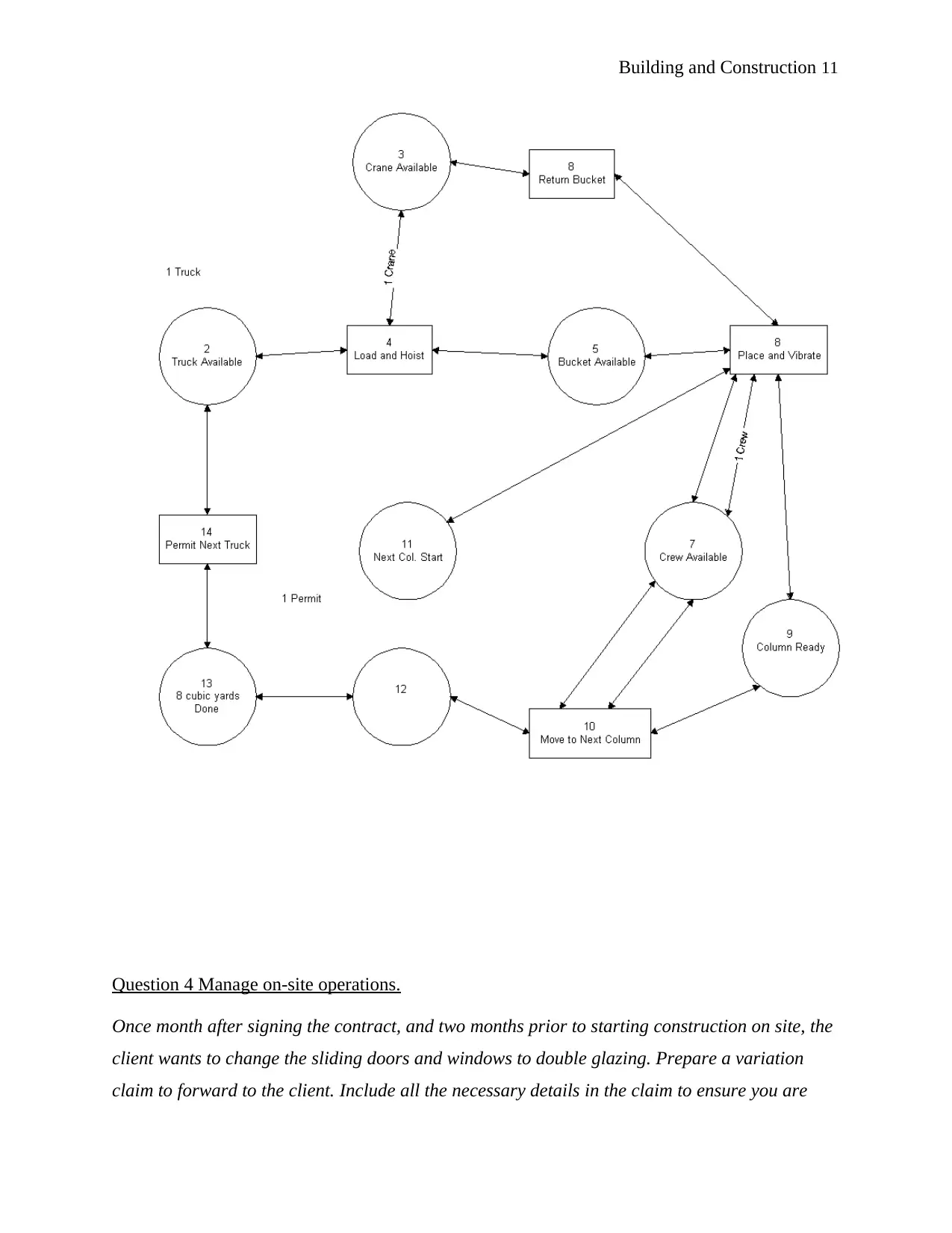
Building and Construction 11
Question 4 Manage on-site operations.
Once month after signing the contract, and two months prior to starting construction on site, the
client wants to change the sliding doors and windows to double glazing. Prepare a variation
claim to forward to the client. Include all the necessary details in the claim to ensure you are
Question 4 Manage on-site operations.
Once month after signing the contract, and two months prior to starting construction on site, the
client wants to change the sliding doors and windows to double glazing. Prepare a variation
claim to forward to the client. Include all the necessary details in the claim to ensure you are
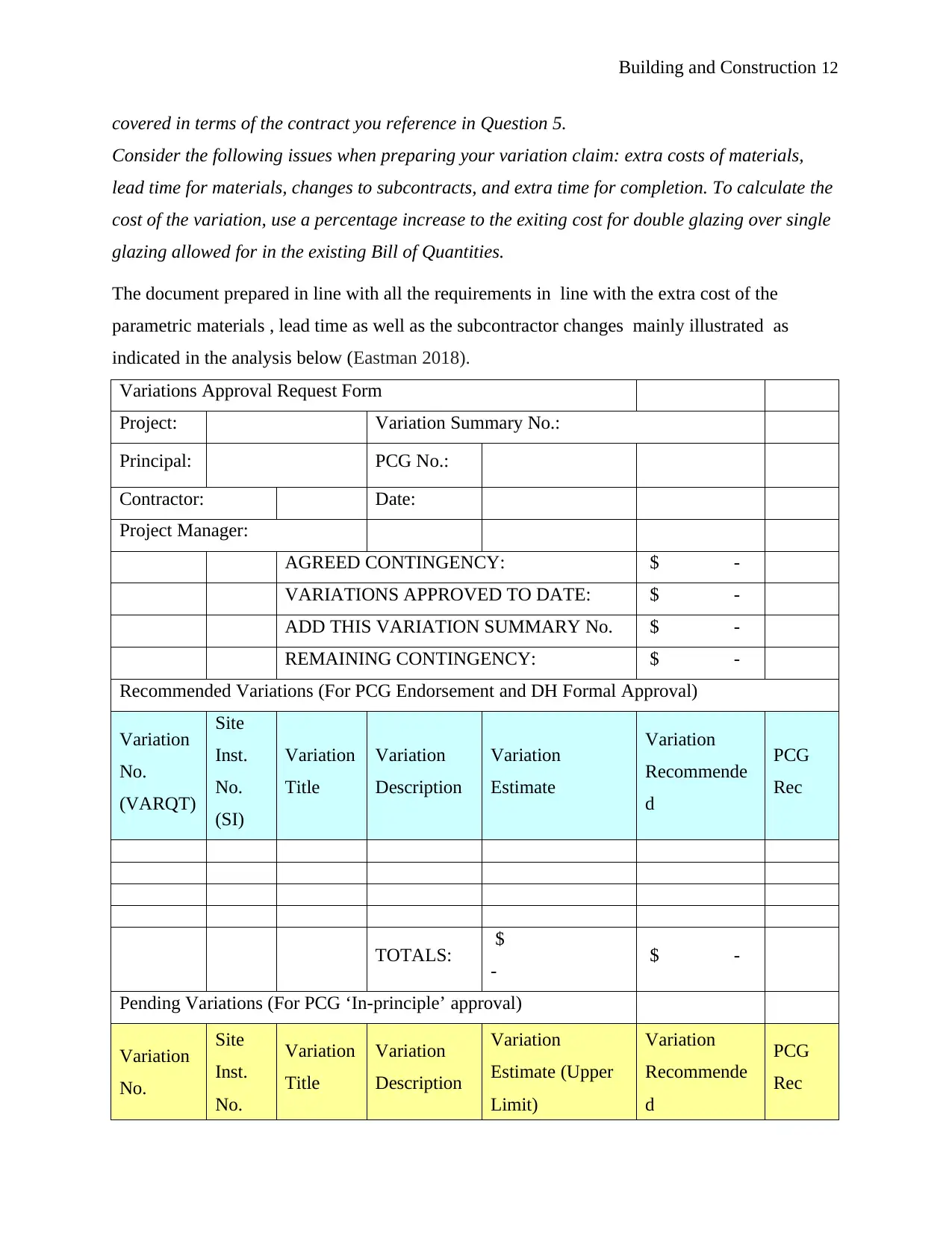
Building and Construction 12
covered in terms of the contract you reference in Question 5.
Consider the following issues when preparing your variation claim: extra costs of materials,
lead time for materials, changes to subcontracts, and extra time for completion. To calculate the
cost of the variation, use a percentage increase to the exiting cost for double glazing over single
glazing allowed for in the existing Bill of Quantities.
The document prepared in line with all the requirements in line with the extra cost of the
parametric materials , lead time as well as the subcontractor changes mainly illustrated as
indicated in the analysis below (Eastman 2018).
Variations Approval Request Form
Project: Variation Summary No.:
Principal: PCG No.:
Contractor: Date:
Project Manager:
AGREED CONTINGENCY: $ -
VARIATIONS APPROVED TO DATE: $ -
ADD THIS VARIATION SUMMARY No. $ -
REMAINING CONTINGENCY: $ -
Recommended Variations (For PCG Endorsement and DH Formal Approval)
Variation
No.
(VARQT)
Site
Inst.
No.
(SI)
Variation
Title
Variation
Description
Variation
Estimate
Variation
Recommende
d
PCG
Rec
TOTALS: $
- $ -
Pending Variations (For PCG ‘In-principle’ approval)
Variation
No.
Site
Inst.
No.
Variation
Title
Variation
Description
Variation
Estimate (Upper
Limit)
Variation
Recommende
d
PCG
Rec
covered in terms of the contract you reference in Question 5.
Consider the following issues when preparing your variation claim: extra costs of materials,
lead time for materials, changes to subcontracts, and extra time for completion. To calculate the
cost of the variation, use a percentage increase to the exiting cost for double glazing over single
glazing allowed for in the existing Bill of Quantities.
The document prepared in line with all the requirements in line with the extra cost of the
parametric materials , lead time as well as the subcontractor changes mainly illustrated as
indicated in the analysis below (Eastman 2018).
Variations Approval Request Form
Project: Variation Summary No.:
Principal: PCG No.:
Contractor: Date:
Project Manager:
AGREED CONTINGENCY: $ -
VARIATIONS APPROVED TO DATE: $ -
ADD THIS VARIATION SUMMARY No. $ -
REMAINING CONTINGENCY: $ -
Recommended Variations (For PCG Endorsement and DH Formal Approval)
Variation
No.
(VARQT)
Site
Inst.
No.
(SI)
Variation
Title
Variation
Description
Variation
Estimate
Variation
Recommende
d
PCG
Rec
TOTALS: $
- $ -
Pending Variations (For PCG ‘In-principle’ approval)
Variation
No.
Site
Inst.
No.
Variation
Title
Variation
Description
Variation
Estimate (Upper
Limit)
Variation
Recommende
d
PCG
Rec
⊘ This is a preview!⊘
Do you want full access?
Subscribe today to unlock all pages.

Trusted by 1+ million students worldwide
1 out of 19
Your All-in-One AI-Powered Toolkit for Academic Success.
+13062052269
info@desklib.com
Available 24*7 on WhatsApp / Email
![[object Object]](/_next/static/media/star-bottom.7253800d.svg)
Unlock your academic potential
Copyright © 2020–2025 A2Z Services. All Rights Reserved. Developed and managed by ZUCOL.

